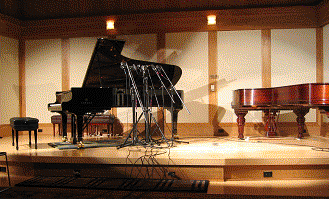Associate Conductor Sarah Hicks led the North Carolina Symphony at Meymandi Hall, Progress Energy Center, in an unusual program devoted to music from Hungarian composers (with one exception, the Ravel “Tzigane,” based on motifs from the music of the Romani). Hungary is a place and culture that is far enough from the American mainstream that I think it is safe to say that we have no prevalent stereotypes regarding Hungary good or bad (the closest might be the Hungarian-speaking count from Transylvania – once part of Hungary, but no longer – in vampire movies). Hungarians are the odd men out in Europe, with a central Asian language unrelated to any other European language whether Romance, Scandinavian, Germanic, or Celtic. And the only music that we tend to associate with Hungary is the music of a non-Hungarian ethnic minority, the Romani.
This was my first exposure to Hicks, who cuts a striking figure on the podium, with long, straight hair, high heels, and an ensemble combining white sleeveless top with black trousers. Her program opened with the Dances of Galanta, probably one of the more frequently heard works of Zoltán Kodály (1882-1967). This 1933 work has a high quotient of exoticism, based on Romani material that takes it quite far from normal harmonic practice for Western European music. Hicks, who studied composition at Harvard and conducting at Curtis, has an expressive yet efficient conducting technique, with no wasted motion and with precise gestures that elicit highly inflected performances from her players. The Dances make virtuoso use of off-beat accents, and under Hicks these were crystal-clear. The whole performance was beautifully polished, leading one to wonder why the composer’s works are not heard more frequently (a recommendation: the Te Deum, from 1936, a fine work which I would wager still awaits its North Carolina premiere).
The first half was filled out with two concertato works. The first was a brief Concertino Semplice for cimbalom and strings (1986) by Kamilló Lendvay (b.1928) performed by Petra Berényi (also from the NCS viola section). The cimbalom is the Hungarian version of the santur or hammered dulcimer, which is large enough to have a pedal, and require legs, but is still trapezoidal in shape, and played with two hammers. The sound was soft enough that it seemed to me that the music stand made a noticeable difference in hearing the higher notes (perhaps, as with guitar concertos, some discreet amplification might have been in order). The idiom was about as modern as we ever hear at the NCS, with a beautifully evocative slow movement, which gave me the sense of a picture of something deeply tragic. Berényi’s playing was fluent and expressive.
Next up was the more familiar “Tzigane” by Maurice Ravel, which opens with a very long rhapsodic solo for the concertato violin, here played by Dovid Friedlander, the NCS Associate Concertmaster. Friedlander did a fine job with the Romani idiom and displayed a secure technique and musicality. If anything were lacking, it might have been a bit more theatricality, a sense of showing the listeners that he possessed a demonic level of technique. Nonetheless, the listeners granted him a standing ovation.
After intermission, the evening concluded with the Bartók Concerto for Orchestra (1943), a lengthy and demanding work in five movements symmetrically framing the elegy at its core. Bartók gives all the sections of the orchestra a chance to shine (particularly in the neo-Baroque Allegretto, with successive pairs of winds in duo). The piccolo (masterfully played by Elizabeth Anderton Lunsford) has such a prominent role in the elegy that one wondered about the program behind it. And indeed, it seems like Bartók must have made a conscious effort to produce an “American,” rather than a Hungarian or European work for this wartime commission for the Boston Symphony Orchestra, particularly with the fourths of the opening motif, which now cannot help but evoke another particularly American theme from 20 years later (“Star Trek”). A fine performance, which deserved the lengthy applause it received. With such fine work, Sarah Hicks will go far.












